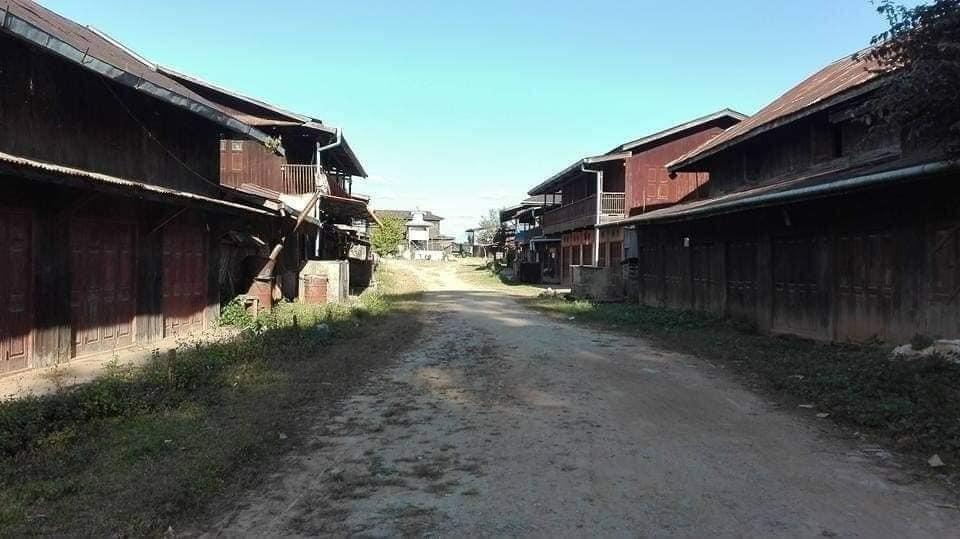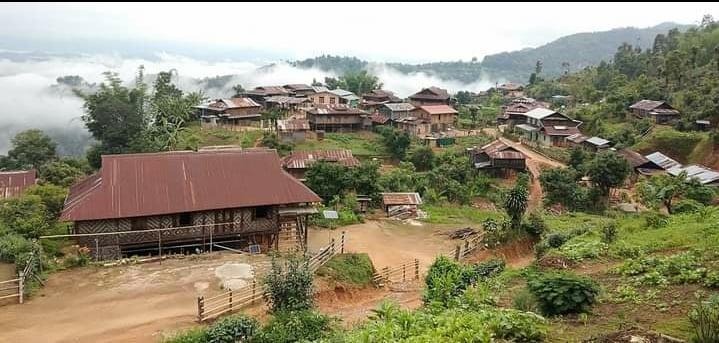Shan Hills has long been plagued by the ominous smell of gunpowder, the echo of gun fires and persisting wave of human rights violations.
.
Previously, human rights violations were primarily attributed to the Bamar/Myanmar military, now known as the State Administration Council (SAC). However, the current situation reveals a wider prevalence of such violations, particularly resulting from conflicts between ethnic armed organizations in Northern Shan State.
In northern Shan State, a crucial intersection is created by the convergence of the China-Myanmar border connection route. This route plays a pivotal role as a key element of the One Belt-One Road initiative, often referred to as the modern Silk Road. The Shwe gas pipeline also passes through the area, facilitating the delivery of gas to China.
The area has also become the battleground for inter-ethnic armed groups, specifically the Taang (Palang) National Liberation Army (TNLA) and the Restoration Council of Shan State Army (RCSS/SSA), who have been engaged in conflict since 2016. The persisting military tensions continue to impact the region to this day.
Similar to this, escalating conflicts between the Restoration Council of Shan State (RCSS/SSA) and the Shan State Progress Party/Shan State Army (SSPP/SSA), two Shan resistance organizations, have been seen in the southern and northern areas of Shan State since 2020.

While these ethnic resistance groups were initially focused on countering the Burmese Army, the current situation has seen them turn against each other, driven by territorial control disputes. As a result of heightened military confrontations, human rights violations have unfortunately become a recurring issue in Shan State.
“In Shan State, we have long endured human rights violations, primarily perpetrated by the Burmese army in the past,” expressed a local woman residing in Kyaukme township, who goes by the name Nang Kham Aung. “However, there has been a concerning shift in recent times, with both the Burmese army and ethnic armed groups engaging in such violations. It is particularly disheartening that our own ethnic armed resistance group is involved in these acts.”
Nang Kham Aung further lamented that for years, the Burmese military has been committing human rights violations with impunity in ethnic areas, and no actions have been taken against them. Now, armed organizations are inflicting similar acts upon our own people, yet there remains a weak mechanism to address these violations.”
Nang Kham Aung expressed, “Currently, there is a conflict in our region between the ‘green’ faction, referring to the SSPP, and the ‘camo’ faction, referring to the RCSS. This division has had a significant impact on the general population, with individuals being labeled as supporters of either side. Even those involved in human rights issues hold varying viewpoints and show favoritism towards one faction.”
During the years, particularly between 1996 and 1998, the military dictatorship executed a four-cut campaign aimed at dismantling Shan resistance organizations in Shan State.
This campaign resulted in severe human rights violations, including instances of rape, murder, and arbitrary detention of hundreds of Shan people. Consequently, numerous local Shan individuals were forced to flee their homes.

The Burmese army targeted the residents of Kun Hein Township in Southern Shan State with a horrific act of brutality on June 16, 1997, which including torture and murder. The Committee for Shan State Unity (CSSU) declared June 16 to be Shan National Human Rights Day in memory of this tragic event.
“The Human Rights Day of the People of Shan State was declared by the CSSU prior to the coup in 2020”, according to Sai Leik. “Shortly after declaring this day to highlight human rights, a coup took place”.
Since the arrival of the Burmese army to Shan State, the armed conflict involving the Burmese army and various armed groups has persisted up to today. The Shan State has seen ongoing violations of human rights as a result of this protracted conflict.
Furthermore, the political upheaval triggered by the coup led by Min Aung Hliang has intensified the already dire situation, exacerbating concerns regarding the rampant violation of human rights in Shan State, added Sai Leik.
“For years, human rights violations have been a persistent issue in non-Bamar ethnic areas,” added Sai Leik. “However, following the coup, human rights violations have extended across the entire country, impacting areas from the northern regions to central Myanmar, where a severe human rights crisis is unfolding”.
Despite the four-cut era and national ceasefire agendas, armed clashes have persisted, despite intermittent ceasefire agreements and peace negotiations between the Burmese regime and ethnic resistance organizations.
The publication of the report titled “License to Rape” by the Shan Human Rights Foundation (S.H.R.F.) shed light on the systematic human rights abuses perpetrated by the Burmese army in various locations throughout Shan State. These revelations of abuse represent one of the darkest and most appalling chapters in history.

In light of these ongoing injustices, a Shan activist who wishes to be identified as Sai Pan, emphasized that unless these injustices are acknowledged and addressed, human rights violations will persist. Efforts to bring about justice and accountability are crucial to ensuring a future free from such violations.
Sai Pan expressed, “As long as injustices remain hidden and perpetrators continue to enjoy impunity without investigation or punishment, human rights violations will persist. This is an unsettling prospect.”
The current situation, with the military in power, has resulted in a weak rule of law, making it challenging to hold individuals and organizations accountable for violating human rights.
“During a coup, when the rule of law is absent, organizations can only monitor and identify cases but lack the authority to take further action. Although these organizations advocate for responsible entities to take action, the decision ultimately rests with the relevant authorities/organizations. This poses a significant barrier and challenge to addressing human rights violations effectively,” stated Sai Pan.
The displaced population impacted by the Four Cut campaigns in 1996-1997 continues to be stateless on the Thai-Myanmar border. The homes and villages they were forced to leave behind remain destroyed and abandoned to this day.
In the regions of Muse, Kyaukme, and Lashio in Northern Shan State, the ongoing armed conflict involving the State Administration Council (SAC), ethnic armed organizations, and clashes among various armed groups continue to result in human rights violations.
Sai Kham, a resident of Muse district, stated that the local population not only endures human rights abuses perpetrated by the SAC military regime but also faces the constant threat of violations from other ethnic armed groups.
“Due to the presence of the Burmese army, ethnic armed forces also emerged. Virtually all armed forces are in some way associated with human rights violations. Even among themselves, despite claiming to be resistance organizations, they struggle to cooperate,” stated Sai Kham.
Communities in central Shan State townships, including Laihka (Lecha), Pang Long (Pin Long), Loi Lem, Mong Keung, Mong Nawng, and Kyethi, currently face circumstances akin to the challenges experienced by Shan communities during the four cut campaign. These communities grapple with issues such as displacement resulting from conflicts between the two Shan Ethnic Armed Organizations (EROs).
In the past, the Burmese army bore sole responsibility for the atrocities committed against the Shan people during the four cut campaign. However, at present, ethnic armed forces, including members of two Shan armed groups, contribute to violations against their own populations, as reported by the Shan Communities.

Sai Leik, a Shan political analyst, highlights the necessity of political system reform. They emphasize the importance of active participation by the people in the fight for their rights and the shaping of their own future.
Sai Leik highlighted that, “Shortly after the CSSU (The Committee for Shan State Unity) declared its commitment to peaceful coexistence, its activities were temporarily suspended at the request of RCSS (Restoration Council of Shan State), a key member of CSSU. Therefore, it is disheartening to see that even a representative body like CSSU, which initiated the recognition of Shan Human Rights Day, is unable to take the lead in safeguarding the rights of the Shan population.”
Sai Leik emphasized the importance of collective unity among various entities and organizations to safeguard the rights of the people and effectively combat human rights violations.
“CSSU is supposed to take a firm stand in front of the public to protect and lead in politics, as well as advocate for the human rights issues faced by the people of Shan State. If all relevant organizations realize this and prioritize the well-being of the people and the national cause with tolerance, we can get back on track,” added Sai Leik.
Reflecting on the original purpose of the Shan State Army, its establishment aimed to safeguard the nation and its people. It was born out of the dedication of 31 Shan youths led by Noom Serk Harn on May 21, 1958, in the forests near the Nam Kyut river, specifically in Mong Tone township. United by loyalty, they embarked on a revolutionary journey.
However, the Shan resistance organizations, which were originally intended to advocate for the national interests of the Shan people, have now become fragmented and divided. Unfortunately, they are unable to even acknowledge the suffering and grievances of the Shan people.
Sai Pan highlighted that as times change, human rights violations also evolve in their forms. It is concerning that organizations claiming to defend people’s rights are not speaking out against the acts committed by the two Shan resistance organizations.
“Human rights organizations should not only speak out against the abuses carried out by the military dictatorship but they should also address the abuses perpetrated by members of ethnic armed groups, including the two Shan resistance groups. There is an urgent need for action, and it is vital to bring the truth and facts to light,” emphasized Sai Pan.
At present, there is a notable recruitment of new members by different armed groups, leading to the displacement of people. Nang Hseng Tai, a resident of Hsipaw, acknowledged that the methods employed by the Shan resistance groups seemed to resemble those used by the Burmese army.
“There is currently a lack of accountability for human rights violations. No organization has yet successfully been able to address the human rights abuses committed by armed forces,” expressed Nang Hseng Tai. She further emphasized, “If we fail to hold each other accountable for these violations, we will struggle to effectively address the grave actions carried out by the Burmese/SAC regime.”
In the present era, it is important for the leaders of all resistance armed organizations to take decisive action against those responsible for human rights violations and take collective responsibility to address these issues. Merely pointing at the military council for violations of human rights is insufficient in today’s situation.
On June 16th, a campaign was initiated within Shan communities, urging them to light candles and offer prayers in remembrance of those who lost their lives during the brutal “Four-cuts campaign” by the military regime. The Shan communities have also asked for the rise of Shan patriots who are willing to publicly denounce the human rights abuses done by various organizations, including the two Shan resistance groups.



